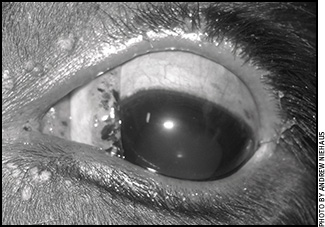Tetanus in Cattle
Common vaccines don’t include protection against tetanus; learn how to protect your cattle.

Abnormally prominent third eyelids, rigid jaw muscles, bloat, and muscle stiffness are symptoms of tetanus in cattle.
Several serious livestock diseases are caused by a group of bacteria called clostridia. Cattle can be protected against the most common ones with seven- or eight-way vaccines, but tetanus is generally not included in those vaccines.
Clostridia can produce deadly toxins that may kill the animal if they get into the bloodstream. Toxins of different types of clostridia vary in their effects and the way they gain access to the bloodstream. These bacteria multiply in the absence of oxygen — such as in a deep puncture wound where the bacteria are not exposed to air, in bruised tissue with compromised blood supply or in certain conditions within the digestive tract.
When they multiply, these bacteria release deadly toxins faster than the body can mount a defense, unless the animal was previously vaccinated, often causing sudden death.
Andrew Niehaus, clinical associate professor for the College of Veterinary Clinical Sciences at Ohio State University, says several vaccines combine protection against most clostridial diseases: blackleg, red water, malignant edema, black disease and enterotoxemia (gut infection) caused by C. perfringens types C and D.
“Some include protection against tetanus (Covexin® 8 by Merck is an eight-way vaccine that includes tetanus), but many do not, and a separate vaccine may be needed for tetanus. Tetanus is included with perfringens in a combination vaccine referred to as C, D and T,” Niehaus says.
Tetanus can occur in any animal if anaerobic conditions in the tissue create a favorable environment for bacterial growth.
“We see this sometimes in calves castrated by banding, as the scrotal tissue dies. Necrotic tissue provides an excellent environment. This is when clostridial organisms produce their deadly toxins,” he explains.
Cows that have retained placenta or metritis may also get tetanus because there is rotting material in the uterus. Most of the time, we don’t worry about cows with retained placenta because they eventually shed those membranes and everything is fine. However, there is risk for tetanus because of the anaerobic environment loved by clostridial organisms, Niehaus explains. The typical history of tetanus in those cows is that they start to show signs of the disease about three weeks after calving. Often they do not show any signs of illness leading up to when they get tetanus. If the cervix closes down, they may not even have vaginal discharge.
“Every case of tetanus that I’ve seen in cattle has been one of those two situations — either a calf with a banded scrotum or a cow that had retained placenta. The clinical signs of tetanus include muscle stiffness; the disease is called lockjaw because the animal can’t open its mouth. A cow may bloat because the rumen has accumulated gas, due to inability to swallow and eructate (expel gas from the rumen),” he explains.
“When you attempt to pass a stomach tube to relieve bloat, you discover that you can’t open the mouth because the jaw muscles are rigid. If you look at the eyes, the third eyelid is frequently more prominent than usual, and pulled up over the eyeball,” Niehaus says.
Treatment is usually ineffective by the time an animal shows signs of tetanus, and it may be impossible to save the animal. To provide protection against tetanus, you usually have to give a separate vaccine — most commonly the C, D and T combination, he says. It is important to read the label on the vaccine because tetanus is not included in many of the seven- or eight-way clostridial vaccines.

Editor’s Note: Heather Smith Thomas is a cattlewoman and freelance writer from Salmon, Idaho.






